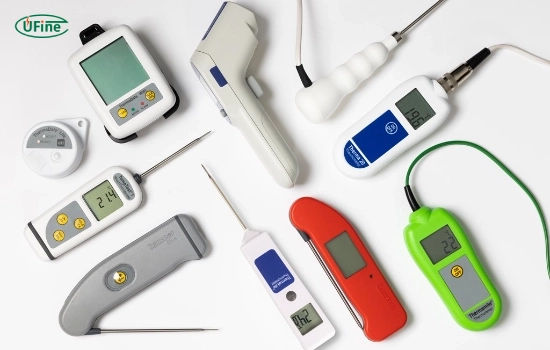
- Part 1. What is a digital thermometer?
- Part 2. What types of batteries do digital thermometers use?
- Part 3. How long do digital thermometer batteries last?
- Part 4. How to change the battery in a digital thermometer?
- Part 5. Why battery life matters for digital thermometers?
- Part 6. Tips for extending digital thermometer battery life
- Part 7. Signs that your digital thermometer needs a new battery
- Part 8. FAQs about digital thermometer battery
Digital thermometers are essential for providing accurate temperature readings in healthcare, cooking, and various industrial settings. However, one aspect often overlooked is the digital thermometer battery that powers these devices, which is critical to ensuring reliable and long-lasting performance. This article will cover everything you need about digital thermometer batteries, including types, maintenance, and frequently asked questions.
Part 1. What is a digital thermometer?
A digital thermometer is an electronic device that measures temperature with high precision. Unlike traditional mercury thermometers, which rely on liquid expansion, digital thermometers utilize electronic sensors to provide rapid readings. They are commonly used in medical settings to check body temperature, in kitchens to monitor food temperatures, and in industrial applications to measure environmental conditions.
Digital thermometers come in various forms, including:
- Oral Thermometers: Designed to measure temperature under the tongue.
- Rectal Thermometers: These are typically used for infants and provide accurate core body temperature readings.
- Axillary Thermometers: Measured in the armpit, these are often less accurate than oral or rectal measurements.
- Infrared Thermometers: These measure temperature from a distance and are often used for measuring surface temperatures without contact.
Part 2. What types of batteries do digital thermometers use?
Digital thermometers typically use one of the following battery types:
- Alkaline Batteries: These are the most common type used in digital thermometers. They provide a stable voltage and are widely available. Common sizes include AA, AAA, and button cells like LR41. Alkaline batteries are favored for their affordability and accessibility, making them popular for everyday thermometers.
- Lithium Batteries: Manufacturers often use lithium batteries in compact digital thermometers because they offer a long shelf life and stability. They can last significantly longer than alkaline batteries, making them ideal for devices used infrequently. Lithium batteries are particularly beneficial in medical thermometers, where reliability is paramount.
- Rechargeable Batteries: Some modern digital thermometers come with built-in rechargeable batteries. These are environmentally friendly and cost-effective in the long run but require a charging station. Rechargeable batteries are increasingly popular due to their sustainability and the convenience of not needing to replace batteries frequently.
Digital thermometers typically use alkaline, lithium, or rechargeable batteries. Lithium batteries are particularly beneficial for medical thermometers due to their long shelf life and stability, ensuring accuracy over extended periods.
What size battery does a digital thermometer use?
Digital thermometers use different thermometer battery sizes depending on the model. The most common sizes are button/coin cells and small cylindrical cells. Always confirm the correct size in the device manual or on the battery compartment.
| Battery Size | Type | Typical Use in Thermometers |
|---|---|---|
| LR41 | Alkaline button cell | Compact oral/rectal thermometers |
| CR2032 | Lithium coin cell | Infrared / ear thermometers, some digital models |
| SR44 (357) | Silver-oxide button | High-precision lab thermometers |
| AAA | Alkaline / NiMH | Larger kitchen or industrial thermometers |
Quick tip: If unsure, open the battery compartment and check the printed code on the old cell, or consult the thermometer manual. For related products and recommended cells, see digital thermometer battery options.
Part 3. How long do digital thermometer batteries last?
Most digital thermometer batteries last between 100–500 hours of continuous use, depending on battery type: alkaline ~100–300 hours, lithium up to ~500 hours or more.
The lifespan of a digital thermometer battery depends on several factors:
- Battery Type: Alkaline batteries typically last between 100 to 300 hours of continuous use, while lithium batteries can last up to 500 hours or more. The choice of battery can significantly impact how often you need to replace it.
- Usage Frequency: The more frequently you use a thermometer, the quicker the battery depletes. For instance, a thermometer used multiple times daily will require more frequent battery changes than one used occasionally.
- Device Efficiency: Designers create digital thermometers to be more energy-efficient, extending battery life. Features like auto shut-off can also help conserve battery power. Understanding these features can help users select the right thermometer for their needs.
How long do digital thermometer batteries last?
- The lifespan of a digital thermometer battery varies based on the type of battery used. Alkaline batteries typically last between 100 to 300 hours, while lithium batteries can last up to 500 hours or more. Regular usage and device efficiency features such as auto shut-off can impact battery life.
Part 4. How to change the battery in a digital thermometer?
Changing the battery in a digital thermometer is usually straightforward. Here’s a step-by-step guide:
- Locate the Battery Compartment: Most digital thermometers have a small compartment on the back or bottom. Look for a sliding cover or screws.
- Open the Compartment: If it has screws, use a small screwdriver to remove them. If it’s a sliding cover, gently slide it open.
- Remove the Old Battery: Take out the old battery, noting its orientation (positive and negative ends).
- Insert the New Battery: Place the new battery in the same orientation as the old one. Ensure it fits snugly.
- Close the Compartment: Replace the cover or screws, ensuring it is securely closed.
- Test the Thermometer: Turn on the device to ensure it’s functioning correctly.
Part 5. Why battery life matters for digital thermometers?
Battery life is a critical consideration when choosing a digital thermometer. Here are some reasons why:
- Reliability: A thermometer with a long battery life reduces the risk of unexpected failures during use, especially in critical situations like medical emergencies. For instance, a low battery in a medical thermometer can lead to inaccurate readings, which could have serious consequences.
- Cost-Effectiveness: Longer-lasting batteries mean fewer replacements, leading to cost savings over time. This is particularly important for families or facilities that rely on multiple thermometers.
- Environmental Impact: Reducing battery waste is essential for ecological sustainability. Devices that consume less power contribute to less battery waste in landfills. Opting for rechargeable options can further minimize this impact.
Part 6. Tips for extending digital thermometer battery life
To maximize the lifespan of your digital thermometer battery, consider the following tips:
- Turn Off When Not in Use: Always turn off the thermometer when it’s not in use to conserve battery power. Some models have an automatic shut-off feature, which can be very helpful.
- Store Properly: Store the thermometer in a cool, dry place. Extreme temperatures can affect battery performance. Avoid leaving it in hot cars or damp areas.
- Avoid Frequent Battery Changes: If possible, use the thermometer regularly to keep the battery active and prevent it from deteriorating from inactivity.
To extend the life of your digital thermometer battery, ensure the device has auto shut-off and always store it in a cool, dry location to prevent premature battery drain.
Part 7. Signs that your digital thermometer needs a new battery
Recognizing the signs that your digital thermometer needs a new battery can save you time and frustration:
- Slow Response Time: If the thermometer takes longer than usual to give a reading, the battery may be weak. This can lead to delays in critical situations, such as fever monitoring.
- Inaccurate Readings: If you notice inconsistent or erratic temperature readings, it could indicate a low battery. This is particularly concerning in medical settings where accurate readings are crucial.
- Display Issues: A dim or flickering display often indicates the battery is running low. If the display is hard to read, it’s time to replace the battery.
Part 8. FAQs about digital thermometer battery
What is the best type of battery for a digital thermometer?
The best type of battery depends on your usage. Due to their longevity, lithium batteries are ideal for frequent use, while alkaline batteries are sufficient for occasional use.
How can I tell if my digital thermometer battery is low?
Most digital thermometers have a low battery indicator. If the display shows a battery icon or the readings become erratic, it’s time to replace the battery.
Can I use rechargeable batteries in my digital thermometer?
Yes, if the thermometer is designed for rechargeable batteries. Always check the manufacturer’s specifications to ensure compatibility.
How do I dispose of old batteries?
Old batteries should be disposed of properly at designated recycling centers or drop-off locations. They should never be thrown in the regular trash, as this can be harmful to the environment.
What should I do if my thermometer battery is not lasting as long as expected?
If your thermometer battery isn’t lasting as expected, ensure you’re using the correct type of battery. Lithium batteries tend to last longer than alkaline. Check for features like auto shut-off to conserve battery life.
Can I replace a rechargeable battery in my digital thermometer?
Yes, many modern thermometers come with rechargeable batteries. Be sure to follow the manufacturer’s guidelines to replace them safely, and choose the appropriate rechargeable battery type for your device.
What should I do if my thermometer stops working after a battery change?
If your thermometer doesn’t work after changing the battery, double-check the battery orientation and ensure it’s properly seated. If it still doesn’t work, consult the manufacturer’s troubleshooting guide.
What size battery for digital thermometer?
Most digital thermometers use small button/coin cells like LR41 or CR2032; larger models may use AAA batteries. Always check the battery compartment or the user manual for the exact size.
What is a thermometer cell?
A thermometer cell is the battery that powers a digital thermometer. Common types include alkaline button cells (e.g., LR41), lithium coin cells (e.g., CR2032), and AAA cells for bigger devices.
Related Tags:
More Articles

Battery Load Test: A Comprehensive Guide
Step-by-step battery load test guide for car, solar & industrial use. Learn how to load test a battery, interpret voltage charts, and avoid common mistakes.
The Comprehensive Guide to Battery Balancing and Battery Balancer
Discover how battery balancers improve lithium battery performance, lifespan, and safety. Learn types, functions, and tips to choose the right balancer.
What Is the Best Voltage for a Chainsaw Battery?
Compare 12V-80V chainsaw batteries for light pruning, medium firewood, and professional cutting. See best battery chainsaw with runtime charts and safety tips.
Lithium VS. Alkaline Batteries: A Comprehensive Comparison
Lithium batteries last 3–7× longer than alkaline and perform better in cold weather. Compare lifespan, cost, safety, and best uses to choose the right battery.
Comparing Lithium-Sulfur and Lithium-Ion Batteries: Which is Right for You?
Compare lithium-sulfur (Li-S) and lithium-ion batteries on energy, lifespan, cost, safety, and applications. Best choice for drones, EVs, and electronics.






